Southwest monsoon season ends with ‘normal’ rainfall; drought-prone Marathwada records highest rainfall departure of 48%
The southwest monsoon season officially ended today, on September 30, with the country witnessing ‘normal’ rainfall as it recorded 99 per cent of the long period average precipitation. However, there are large scale monthly variations in rainfall received in the four months of the monsoon season. Excess rainfall in September has balanced out the rain deficit in the country, but farmers in several states have suffered heavy crop losses.

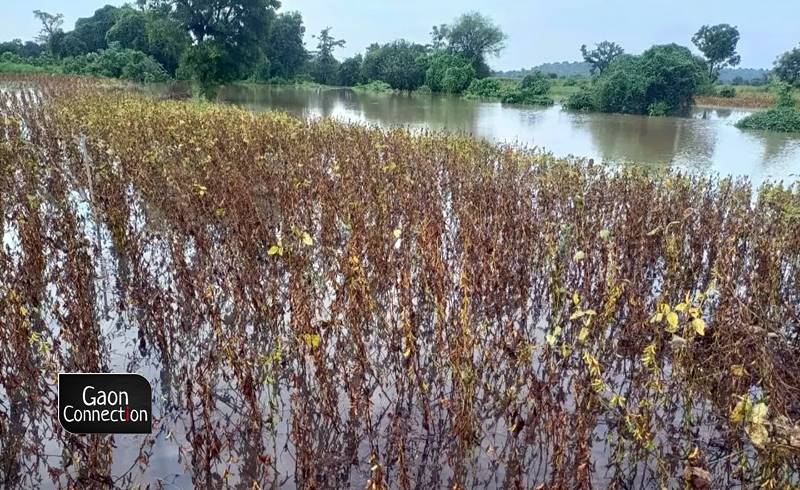
A soybean crop, submerged and rotting due to heavy rains. Photo by arrangement.
The four-month long southwest monsoon season ended today on September 30. As per the India Meteorological Department (IMD), the rainfall during June to September months for the country as a whole has been ‘normal’.
Out of the total 36 meteorological subdivisions in the country, 20 subdivisions constituting 58 per cent of the total area of the country have received normal seasonal rainfall. Ten subdivisions received excess rainfall, whereas six subdivisions received deficient monsoon season rainfall.
Incidentally, Marathwada, which is a drought-prone subdivision in Maharashtra and also infamous for farmers’ suicides, has recorded the highest rainfall departure in the country as it has received an excess rainfall of 48 per cent in this southwest monsoon season (June 1 to September 30).
The six met subdivisions that received deficient rainfall include Nagaland, Manipur, Mizoram & Tripura; Assam and Meghalaya; Arunachal Pradesh; Jammu & Kashmir and Ladakh; West Uttar Pradesh; and Lakshadweep.
Graph: Region-wise distribution of rainfall in India (2021)
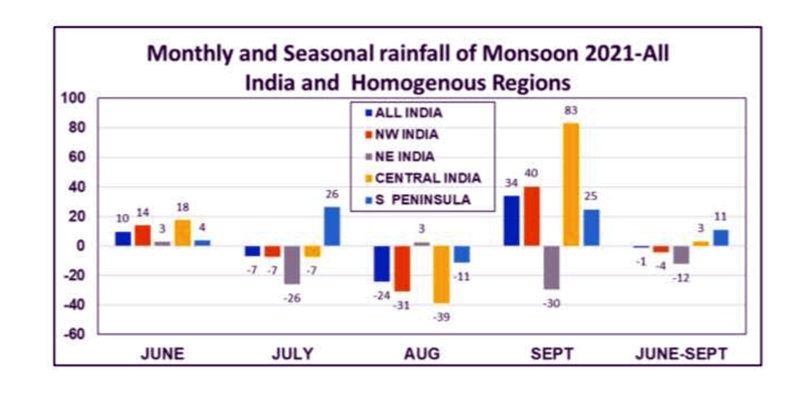
Wide variations in monthly rainfall
In its statement ‘Salient Features of Monsoon 2021’ issued today, the IMD notes: “Considering month to month rainfall variation over India as a whole, the season is very uniquely placed in the historical record for its distinct and contrasting month to month variation. The rainfall over the country as a whole was 110%, 93%, 76% and 135% of LPA during June, July, August and September respectively.”
Thus, September has been the rainiest month of the southwest season this year. And heavy rainfall has led to huge crop losses in several states of the country.
In terms of ‘large excess’ rainfall (actual rainfall being more than 60 per cent of the normal rainfall) received in the month of September, Saurashtra and Kutch met subdivision have recorded the highest departure of 453 per cent above its normal rainfall. This is followed by West Rajasthan subdivision with a rainfall departure of 283 per cent.
Map: Rainfall pattern across 36 meteorological subdivisions in India (2021)
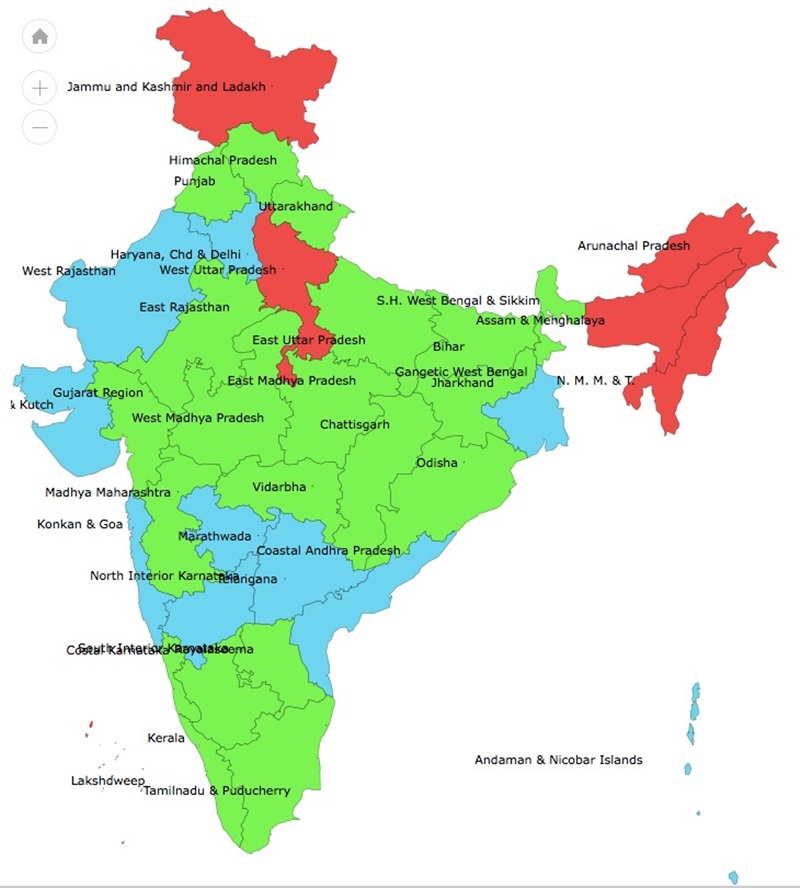
Other states that have registered large excess rainfall in September are: Gujarat (400.5 mm, 268 per cent excess), Rajasthan (175.3 mm, 175 per cent excess), Haryana (187.5 mm, 139 per cent excess), Maharashtra (350.5 mm which is 95 per cent excess), Telangana (290.1 mm which is 78 per cent excess), and Punjab (143.2 mm, 77 per cent excess).
Meanwhile, excess rainfall in September has sufficiently levelled the monsoon rain deficit in the country which hovered around minus 10 per cent in August, and has now reduced to minus one per cent.
Farmers in Marathwada suffer heavy crop losses
Manoj Laxmanrao Shembde, a farmer from Khalegaon village in Georai tehsil, about 35 kms away from Maharashtra’s Beed district headquarters, told Gaon Connection that his yield consisting of cotton, soybean, pigeon pea and peanuts is all ruined due to incessant rains. Cyclone Gulab has led to heavy rainfall and flash-floods in Marathwada region of the state where Beed district is located.
Also Read: Maharashtra’s food output to fall sharply as a result of climate change post 2033: Study
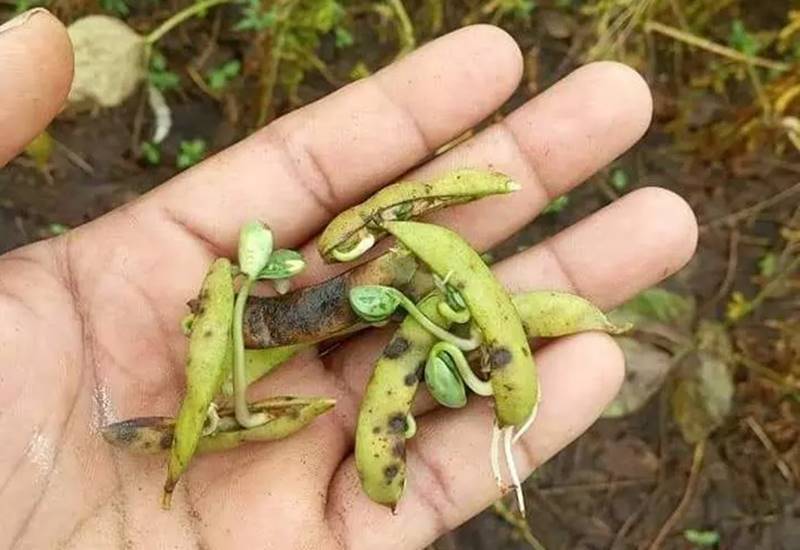
“My family owns 17 acres (6.8 hectares) of land. Our entire crop is lying in submerged fields and destroyed,” Shembde, told Gaon Connection. “There are much smaller farmers in my village whose debts shall increase and they will have to migrate to far off places to work as agricultural labourers as they have no means of livelihood left,” the distressed farmer added.
Five months back, hailstorms had posed a similar crisis for the Marathwada farmers and many farmers like Shembde were hoping to get some relief by moving on to the kharif crop but heavy rains in September have washed away their hopes.
Many farmers have also mortgaged their valuables and availed loans to afford the investment required to cultivate the fields. But crop failure due to incessant rains has quashed their hopes of repaying the loans in this season.
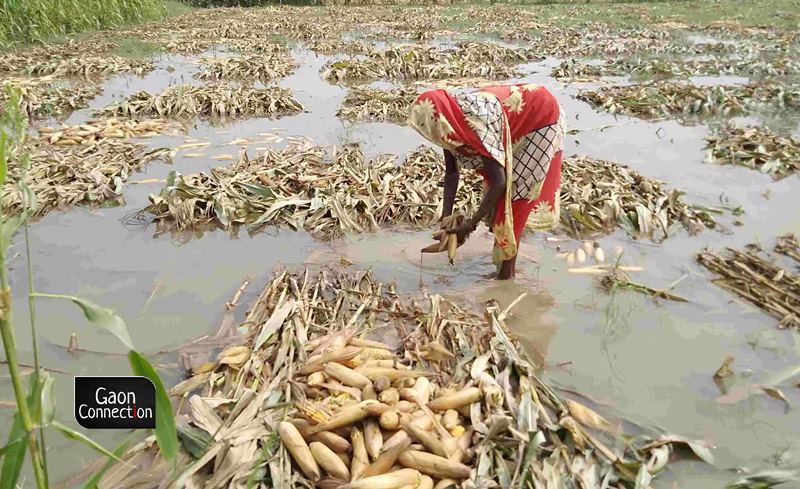
One such farmer is Gajanan Girde who mortgaged his gold to avail a loan of Rs 200,000. “Banks provide gold loans at a per cent or 1.75 per cent but they ask for a lot of documents and paperwork which is a hefty process. But private moneylenders provide loans easily but at a higher interest rate of about three per cent,” 55-year-old Girde, who’s a father of three children told Gaon Connection.
“I cultivate on 12 acres (4.85 hectares) of land but it’s family property and my brothers also have shares. So, due to personal reasons, I could not get the loan through banks and approached a private lender to get two lakh rupees (Rs 200,000). I cultivated soybean on eight acres and cotton on four acres. All that is spoiled due to heavy rains. I cannot think of how would I repay the loan and get my gold back,” the farmer said with a perceptible anxiety in his voice.
Maharashtra, most vulnerable to climate change
A study published in the peer reviewed journal Springer Nature on January 8, 2021 and titled as Future Climate Change Scenario over Maharashtra, Western India: Implications of the Regional Climate Model for the Understanding of Agricultural Vulnerability noted that Maharashtra is on course to face worse effects of the climate change after 2033 which will compromise food production in the state and affect the food security of the country at large.
Rahul Todmal, the professor who carried out the above mentioned study, stated that the rise in the future temperature due to global warming will reduce the agricultural productivity of rain-fed regions like India’s Marathwada.
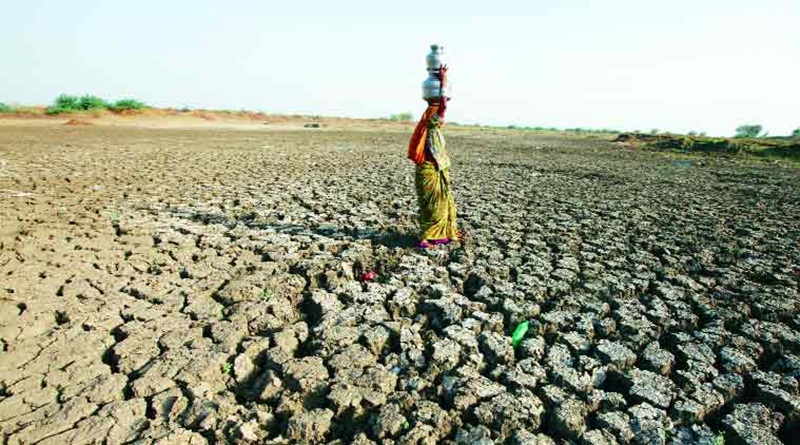
“Agronomic studies have confirmed that the warmer climatic conditions never favour agricultural productivity. The future rise in temperature is very likely to reduce the productivity of traditional rain fed (jowar, bajra, pulses) crops and irrigated cash crops (sugarcane, onion, maize, etc.) as well,” the professor was quoted.
Also, the United Nations’ Intergovernmental Panel on Climate Change (IPCC) released a report on August 9 which warned that the effects of climate change cause intense precipitation events that can lead to floods and crop damage.
The high vulnerability of farmers in the Marathwada often leads the poor cultivators in the region to end their lives. According to an Right to Information (RTI) query filed by RTI activist Jeetendra Ghadge, at least 693 farmers died by suicide in Marathwada between January 2020-November 2020. The farmers suicide crisis in Marathwada has also earned it the epithet of ‘farmer suicide capital of India’.
Southwest monsoon 2021 withdrawal
As per the IMD, the withdrawal of southwest monsoon from some parts of northwest India is expected from around October 6. There is a forecast of an intense spell of rainfall over Bihar till October 2, and over Jharkhand and Gangetic West Bengal today, September 30, and decrease thereafter. Also, an increase in rainfall activity over south Peninsular India is forecasted from October 1.
Northeast monsoon 2021 forecast
As per the IMD, the northeast monsoon (October to December ) season rainfall over the south Peninsular India consisting of five meteorological subdivisions – Tamil Nadu, Coastal Andhra Pradesh, Rayalaseema, Kerala and South Interior Karnataka – is most likely to be normal (89-111 per cent of Long Period Average (LPA)).
The south Peninsular India receives about 30 per cent of its annual rainfall during the northeast monsoon season, which starts from tomorrow, October 1. Tamil Nadu in particular receives about 48 per cent of its annual rainfall during this season.
With inputs from Arvind Shukla

